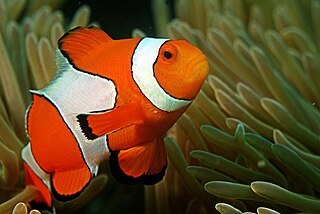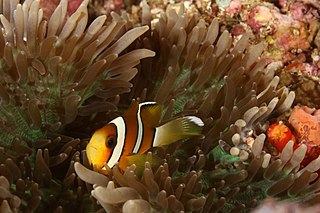
Clark's anemonefish, also known as the yellowtail clownfish, is a marine fish belonging to the family Pomacentridae, the clownfishes and damselfishes.

Radianthus magnifica, also known by as magnificent sea anemone or Ritteri anemone, is a species of sea anemone in the family Stichodactylidae that is native to the Indo-Pacific.

The ocellaris clownfish, also known as the false percula clownfish or common clownfish, is a marine fish belonging to the family Pomacentridae, which includes clownfishes and damselfishes. Amphiprion ocellaris are found in different colors, depending on where they are located. For example, black Amphiprion ocellaris with white bands can be found near northern USA, North America, Australia, Southeast Asia, and Japan. Orange or red-brown Amphiprion ocellaris also exist with three similar white bands on the body and head. Amphiprion ocellaris can be distinguished from other Amphiprion species based on the number of pectoral rays and dorsal spines. Amphiprion ocellaris are known to grow about 11 cm long. Like many other fish species, females are, however, larger than males. The life cycle of Amphiprion ocellaris varies in whether they reside at the surface or bottom of the ocean. When they initially hatch, they reside near the surface. However, when Amphiprion ocellaris enter into the juvenile stage of life, they travel down to the bottom to find shelter in a host anemone. Once they find their anemone, they form a symbiotic relationship with them.

The sebae anemone, also known as leathery sea anemone, long tentacle anemone, or purple tip anemone, is a species of sea anemone in the family Stichodactylidae and native to the Indo-Pacific.

The orange-fin anemonefish is a marine fish belonging to the family Pomacentridae, the clownfishes and damselfishes, found in the Western Pacific north of the Great Barrier Reef from the surface to 20 m, to include the Pacific Ocean between Queensland, Australia, and New Guinea to the Marshall and Tuamotus Islands. It can grow to 17 cm in length.

Amphiprion polymnus, also known as the saddleback clownfish or yellowfin anemonefish, is a black and white species of anemonefish with a distinctive saddle. Like all anemonefishes it forms a symbiotic mutualism with sea anemones and is unaffected by the stinging tentacles of the host anemone. It is a sequential hermaphrodite with a strict sized-based dominance hierarchy: the female is largest, the breeding male is second largest, and the male non-breeders get progressively smaller as the hierarchy descends. They exhibit protandry, meaning the breeding male will change to female if the sole breeding female dies, with the largest non-breeder becomes the breeding male.

Amphiprion akindynos, the Barrier Reef anemonefish, is a species of anemonefish that is principally found in the Great Barrier Reef of Australia, but also in nearby locations in the Western Pacific. The species name 'akindynos' is Greek, meaning 'safe' or 'without danger' in reference to the safety afforded amongst the tentacles of its host anemone. Like all anemonefishes it forms a symbiotic mutualism with sea anemones and is unaffected by the stinging tentacles of the host anemone. It is a sequential hermaphrodite with a strict size-based dominance hierarchy: the female is largest, the breeding male is second largest, and the male non-breeders get progressively smaller as the hierarchy descends. They exhibit protandry, meaning the breeding male will change to female if the sole breeding female dies, with the largest non-breeder becomes the breeding male. The fish's natural diet includes zooplankton.

The Red Sea Clownfish, commonly known as the Red Sea or two-bandedanemonefish is a marine fish belonging to the family Pomacentridae, the clownfishes and damselfishes. Like other species of the genus, the fish feeds on algae and zooplankton in the wild.

The three-band anemonefish is a species of anemonefish endemic to the Marshall Islands in the western part of the Pacific Ocean. Like all anemonefishes, it forms a symbiotic mutualism with sea anemones and is unaffected by the stinging tentacles of its host. It is a sequential hermaphrodite with a strict size-based dominance hierarchy; the female is largest, the breeding male is second largest, and the male nonbreeders get progressively smaller as the hierarchy descends. They exhibit protandry, meaning the breeding male changes to female if the sole breeding female dies, with the largest nonbreeder becoming the breeding male. The fish's natural diet includes zooplankton.

The nosestripe clownfish or nosestripe anemonefish, skunk clownfish, Amphiprion akallopisos, is an anemonefish that lives in association with sea anemones. A. akallopisos is found in the Indian Ocean. It resides in shallow inshore reefs as deep as 15 m with a moderate to strong current. The skunk clownfish can also be kept in captivity by aquarists.

Stichodactyla haddoni, commonly known as Haddon's sea anemone, is a species of sea anemone belonging to the family Stichodactylidae. It is found in the Indo-Pacific area.

Stichodactyla mertensii, commonly known as Mertens' carpet sea anemone, is a species of sea anemones in the family Stichodactylidae. It is regarded as the largest sea anemone with a diameter of over 1 m (3.3 ft), the next largest being Heteractis magnifica, which has longer tentacles. This species has an oral disc that can be described as more ovoid than circular that contours to the surrounding substrate and is attached to the substrate by adhesive verrucae, which are wart-like projections. Its blunt or pointed tentacles are uniformly shaped, and are only about 1–2 centimetres (0.39–0.79 in) long. It contains obligate symbiotic zooxanthellae, and is a host to around half the species of anemonefish and one damselfish, Dascyllus trimaculatus.

Stichodactyla is a genus of sea anemones, of the family Stichodactylidae. They are host anemones, which maintain a relationship mutualistic with other animals, in their case with crabs of the genus Mithraculus, shrimp of the genus Periclimenes , and with various species of clownfish, of the genus Amphiprion, establishing a relationship of coexistence. In this way, crabs and fish protect themselves from their predators between the stinging tentacles of the anemone, and the anemone benefits from the cleaning of its oral disc and tentacles as a result of the continuous movements of the animals.

Actinia is a genus of sea anemones in the family Actiniidae. Actinia display a rare form of heteromorphosis in which a cut inflicted on a specimen can develop into a second mouth.

Anemonia is a genus of sea anemones belonging to the family Actiniidae.

Palythoa is a genus of anthozoans in the order Zoantharia.

Amphiprion chrysogaster, the Mauritian anemonefish, is a marine fish belonging to the family Pomacentridae, the clownfishes and damselfishes. It is endemic to Mauritius and probably Réunion.

Amphiprion leucokranos is a naturally occurring hybrid anemonefish found in the western central Pacific Ocean. Like all anemonefishes it forms a symbiotic mutualism with sea anemones and is unaffected by the stinging tentacles of the host anemone. It is a sequential hermaphrodite with a strict dominance hierarchy, features which are critical to the direction of gene flow.

Stichodactyla tapetum, commonly known as maxi-mini carpet anemone, is a species of sea anemone in the family Stichodactylidae. It is found in the Indo-Pacific area, primarily around Vietnam.





















